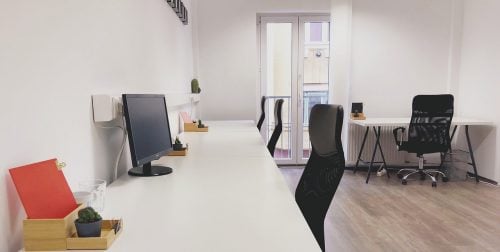Hot desking: What is it?
Hot-desking is a workplace scheme in which the desks in an office belong to nobody in particular. Users can claim their desk for the day either on a first come first served basis, or through a reservation system.

Image: theotherworkspace on pixabay
The term can apply to a whole workplace or to a single work station. For example:
Our company is getting rid of personal desks and introducing hot-desking.
I have my own desk at my usual place of work but I book a hot desk when I visit another branch.
Some schemes operate on a first come first served basis. Others operate on a booking system. The second type is also known as “hoteling.” Some firms implement hot desks as a part of a flexible working strategy.
The approach appears to be popular with large firms, such as Deloitte, Microsoft, Citigroup, and Lego. Figures that a Deloitte article on future workplaces refers to suggest that 45 percent of multinationals were planning to have hot desks by 2020.
Concerns about desk-sharing
Those not in favor of hot-desking say that introducing the scheme purely to cut cost might be counter-productive. Some have suggested that it destroys morale and reduces productivity. One Forbes article went so far as to state that – unless you are a small firm or have an itinerant workforce – “hot-desking will kill your company.”
Critics list numerous drawbacks, such as staff wasting time as they search for desks, set up computers, and adjust furniture. Disruption to collaborative work due to team members not finding seats near each other is another criticism.
Implement with care
However, advisors on workspace use argue that, implemented correctly, desk-sharing should have the opposite effect. The result should be increased autonomy, collaboration, and flexibility.
Many companies introduce hot-desking to make better use of their real estate. However, while cost-cutting might be a factor, it should not be the only one. Employers also need to consult their people, tailor the system to their needs, and put in place the right tools to make the system work.
One expert suggests that there is a lack of evidence that introducing hot desks kills morale. Tim Oldman, founder and CEO of Leesman, says that many companies with “unassigned desk solutions” score highly on workplace designs that support employees. He advocates putting users at the center of the design, noting that “the employee is the profit center – not the real estate footprint.”
How it works
A company can operate the system in its own workplace or hire a firm to provide hot-desking services. There are also firms that offer the service in their own dedicated offices to client companies.
The following is an example of a first come first served system in the sales department of a large firm.
Janice is a sales representative. She spends four days a week out of the office, mostly to visit clients. On the day that she works at the office, she likes to get in early as usually this means that her favorite workstation is free. The desk is next to a window that overlooks a garden. There is a docking station and phone on the desk. Nearby is a dispenser stocked with antibacterial wipes.
After wiping the desk, the screen, and the phone, Janice sits and adjusts the chair. She plugs her laptop into the docking station and goes to grab a coffee. She returns to the desk and enters her personal code into the phone. This causes the communication system to download her preferences, settings, and contacts to the phone. The phone effectively becomes hers; e.g., she can receive direct calls and use her personal speed dial settings.
Food for thought
The following list is a sample of points to consider when introducing and running a hot-desking system.
- Get the technology right: Ensure IT systems are compatible and that work stations are easy to repair or replace. Login should be quick and straightforward. Ensure that the phone system supports hot-desking.
- Put people at the center: Engage staff in the design, tailor the systems to their needs, and help them transition to the new scheme. Seek and act on feedback and suggestions for improvement.
- Get the usage policies right: These should cover hygiene (e.g., the need to keep surfaces clean and wash hands to minimizing spread of germs), noise, tidiness, and avoidance of cliques and territory staking.

